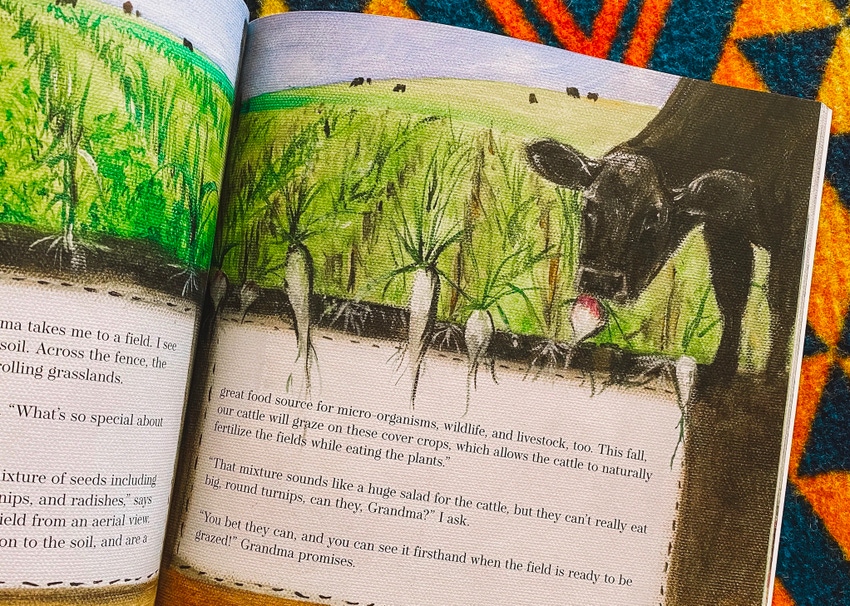Earth Day: The 5 principles of soil health
Ranchers play a pivotal role in maintaining wildlife habitat, promoting soil health, caring for natural resources and providing food for a hungry planet.
April 21, 2021

I am becoming increasingly concerned about the political movements that aim to strip ranchers off the land and beef off the dinner table in the name of climate change.
First, there’s President Biden’s 30X30 plan, which is a global effort designed to “protect” 30% of the Earth’s land and water by 2030.
Then, there’s Representative Alexandria Ocasio-Cortez’s Green New Deal, which was re-introduced this week and seeks to address the “exacerbated systemic racial, regional, social, environmental, and economic injustices” in this country through climate change mitigations.
And mostly, I’m left scratching my head wondering how we got here, and how we can get back to reminding society that the agricultural community was green way before green was cool.
There’s a misconception out there that in order for the land to be healthy and vibrant, it needs to be left alone. Yet, without proper management through responsible grazing and logging, as examples, the land can become overrun with dead timber and brush.
I’m an accidental pandemic homeschooling mom, and in the theme of Earth Day, our kids learned this week about multi-purpose land use which include:
1. Wildlife habitat
2. Natural resources (timber, mineral, water, coal, oil)
3. Agriculture (grazing animals, farming)
4. Recreation (hunting, fishing, camping, hiking, exploring)
These four can work together in conjunction with responsible caretakers, who deeply love the land, the animals, and people, too.
To negate this truth is a fantasy that ultimately results in poorly managed land, depleted natural resources, less habitat for wildlife and more expensive fuel, food and fiber, which ultimately hurts the lower class in our society.
Today is Earth Day, and I would like to highlight a few ways that ranchers are true environmental stewards. Sure, sustainability is a buzz word, but we don’t seek to “sustain” our land’s natural resources; we work to improve and enhance the land, water, soil and habitat that God has bestowed for us to care for.
On our ranch, we practice the five principles of soil health. We have benefited from the South Dakota Soil Heath Coalition (SDSHC) in learning more about what these principles are, and last year, I had the opportunity to explore these themes in a children’s book titled, “The Soil Quilt.” I would encourage you to check out the book and share it with young readers in your communities.
The five principles of soil health include:
1. Soil cover — Keeping plant residues on the soil surface to minimize erosion, reduce weed pressure, moderate soil temperatures, retain moisture, reduce compaction and create a home for biology to thrive. Earthworms thrive on decaying plant matter, and these worms serve as soil aerators and fertilizers.
2. Minimizing soil disturbance - We seek to limit soil disturbance by practicing no-till farming and limiting our use of chemical interruptions. Our pastures are home to native grasslands, which have incredibly deep root systems, and we plant cover crops and forage crops such as sudan grass and oats. More on that in principle three.
3. Diversity - According to the SDSHC, “Our prairie soils were built under a widely diverse plant community. This plant community consisted of grasses, sedges, nitrogen fixing legumes, wildflowers, forbs, and more, all with different root types and depths. The prairie ecosystem didn’t just provide for the bison, deer and pronghorn, it also provided for the soil fungi, bacteria, and worms. So, it seems to make sense that if we want to build healthy soils, we need to feed the soil a healthy, diverse diet.
“If you currently graze perennial pasture that has never been sod-busted, you may have many of the original prairie plants already. To keep or increase the diversity of your plant community, proper grazing management is key. Change season of use yearly, stock properly, rotate regularly.
“On the crop production side, try to imitate the native plant community, which consisted of warm and cool season grasses and broadleaves. This can be done through crop rotation and the use of cover crops. If one or two of these crop types doesn’t fit into your operation, consider planting a cover crop mix with that crop type in the mix. By having all four categories in your rotation, you can help feed a more diverse soil microbiome.”
4. Living roots - Plants are a key energy source for health soils, and prairie grasslands provide living roots from spring thaw to the fall freeze.
SDSHC offers tips for how to extend the amount of time a living root is interacting with the soil.
SDSHC says, “How do we extend the amount of time a living root is interacting with the soil? Most of our cash crops have a living root for 12-15 weeks after planting, which is less than 30% of the year. Native prairie has a living root for 60% or the year, or more. Diversifying crop rotations and cover crops help fill the gaps. Even in the northern plains we have potential for a living cover prior to cash crop planting and post-harvest.”
5. Integrating livestock - Last but not least, ruminant animals such as cattle and sheep benefit the soil and our environment in countless ways. When cattle graze, they aerate the soil with their hooves. They fertilize the land with their manure. They participate in the water cycle. They maintain wild life habitat by removing brush to encourage new growth. They utilize land that cannot be modernized or farmed. And they convert inedible cellulosic materials to nutrient-dense beef and life-enriching by-products.
What’s more, SDSHC explains, “Animals, plants and soils have played a synergistic role together over geological time. In recent years, animals are playing a reduced role due to being placed in confinement and fewer farms now include livestock as part of their overall operation.”
Returning livestock to the landscape, not removing them from the equation, would be beneficial in a variety of ways including balancing the carbon/nitrogen ratio, improving regrowth, reducing nutrient export, providing livestock a nutritional diet, improving water quality and reducing livestock waste.
As producers, we can always improve the practices we are doing and aim to make the land better year after year. None of us are perfect. We do what we can with the equipment we have and the practices that make sense when considering our environment, weather, production goals and other factors. However, this new political movement hardly seems to address climate concerns; instead it looks a lot more like an attack on our food security, our sovereignty and our rights as private landowners.
The truth is in our favor, but it is up to each of us to share the stewardship practices we are following day-after-day to care for our natural resources, our livestock and the people we aim to serve.
From my ranch to yours, happy Earth Day!
The opinions of Amanda Radke are not necessarily those of beefmagazine.com or Farm Progress.
About the Author(s)
You May Also Like




.png?width=300&auto=webp&quality=80&disable=upscale)
